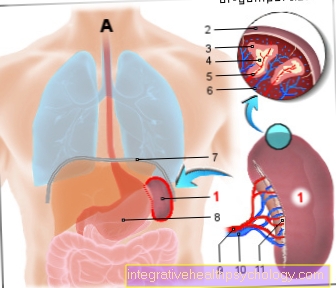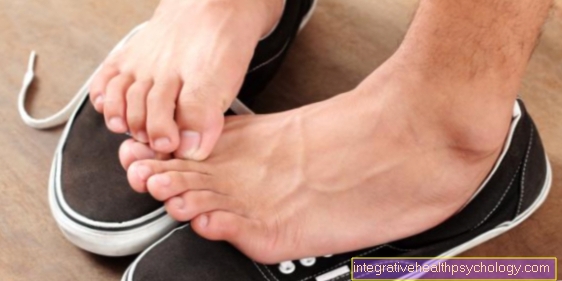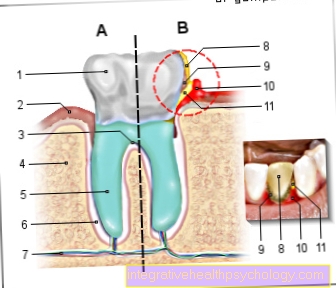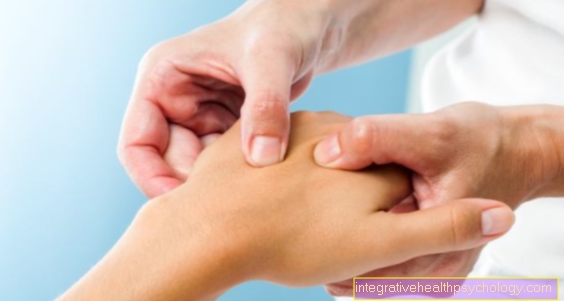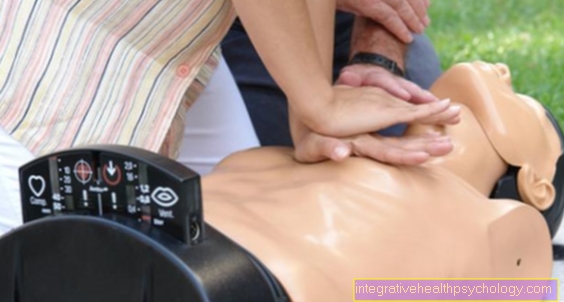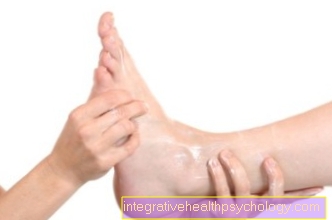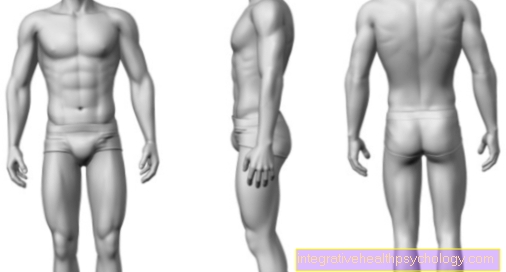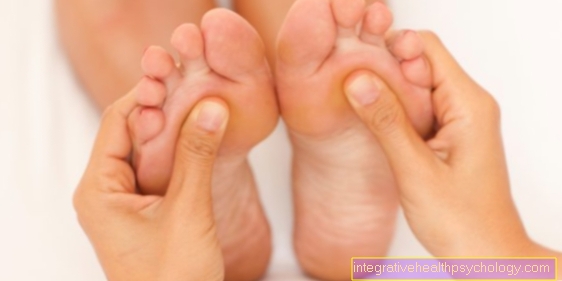Heberden osteoarthritis
Definition - what is Heberden's osteoarthritis?
Heberden's arthrosis, named after the London doctor William Heberden, is arthrosis that affects the end joints of the fingers. The development of osteoarthritis is idiopathic and is influenced by genetic and hormonal factors. Women are affected around ten times as often as men.
Clinically, Heberden's osteoarthritis manifests itself in the form of cartilaginous, bony knots on the distal phalanges of the fingers, pain and restricted movement in the distal finger joint. There are both conservative and surgical treatment options that can be used depending on the symptoms and stage.

causes
Heberden's osteoarthritis is a degenerative, non-inflammatory disease of the cartilage of the end joints of the fingers. It is said that osteoarthritis is idiopathic because it develops by itself without a clearly identifiable cause. However, there are some important risk factors associated with developing Heberden's osteoarthritis. Osteoarthritis usually occurs as a physiological symptom of old age.
Heavy strain on the fingers can increase the risk. In particular, activities that involve a lot of computer work and manual work areas in which the fingers are bent and stretched a lot are associated with an increased risk of developing Heberden osteoarthritis.
Other risk factors are old age and a family disposition. If there is a rheumatic joint disease, this also promotes the development of osteoarthritis. Heberden osteoarthritis seems to be influenced by hormones. It occurs much more often in women than in men and is particularly noticeable in women during menopause.
You might also be interested in: Rheumatoid Arthritis
You can recognize Heberden osteoarthritis by these symptoms
The main characteristic of Heberden's osteoarthritis is the involvement of the finger end joints. These are the joints of the fingers that are furthest away from the body and connect the middle phalanx with the end phalanx. The index and little fingers are particularly often affected. These joints change degeneratively in the context of osteoarthritis.
Heberden nodes can typically be seen in those affected. These are gnarled, bony growths on the extensor side (back of the hand) of the phalanxes of the fingers. The joints are often changed in such a way that the phalanges of the fingers deviate to the side of the thumb. Those affected suffer from severe pain in the end joints of the fingers, a loss of strength and restricted movement of the fingers.
Read more on the topic: Pain in the interphalangeal joints.
It is also not uncommon for the median joints of the fingers to be affected, Bouchard's arthrosis, and the saddle joint of the thumb, rhizarthrosis. In the later course of the disease, nocturnal pain and sensitivity to the weather can occur. Typically, the sick suffer from increasing mobility restrictions, especially after getting up (morning stiffness).
Pain
Pain is a very unpleasant symptom that occurs early in Heberden's osteoarthritis. In the early stages, those affected typically suffer from pain on exertion, i.e. when the joint is fatigued. The pain can spread to the entire finger. The pain gets worse as the disease progresses. They can persist in advanced stages and significantly worsen the movements of the affected fingers. Night pain can also occur in the late stages.
This topic may also be of interest to you: Carpal tunnel syndrome
Osteoarthritis attack
Symptoms often appear a few years before the actual diagnosis. In the early stages, the symptoms are sometimes dismissed as excessive stress and the symptoms can be alleviated through conservative measures, immobilization and pain medication. Those affected with Heberden's osteoarthritis often report a wave-like course of symptoms with occasional symptom-free intervals. The periods of time between the discomfort intervals typically become shorter as the osteoarthritis progresses. In principle, flare-ups do not occur.
You might also be interested in this topic: Osteoarthritis attack
Heberden knot
The cartilaginous-bony growths that occur in Heberden's osteoarthritis are called Heberden's nodes. The nodes are located on the extensor surfaces of the affected fingers in the area of the phalanxes. This means that they occur on the side of the back of the hand. Heberden's nodes can appear with local inflammatory symptoms. They can be red, tender to tender, and warm, and they can worsen the movement of the affected joint.
You might also be interested in this topic: Heberden nodules
diagnosis
Due to the characteristic Heberden lump and the symptoms, Heberden osteoarthritis is a so-called eye diagnosis. In order to reliably detect Heberden's osteoarthritis, X-rays of both hands are carried out in two planes. The osteoarthritis is very clearly detectable in the X-ray images, so that an anamnesis, a physical examination and the X-rays are sufficient to make the diagnosis of Heberden's osteoarthritis.
Treatment / therapy
Heberden's osteoarthritis is treated conservatively in the early stages of the disease. For this, anti-inflammatory pain relievers such as ibuprofen or diclofenac are used, as well as cortisone injections into the affected finger joints. In addition, the affected joints are immobilized, for example using splints, bandages or self-applied wraps.
Physiotherapy exercises, occupational therapy and physical therapy, such as cold applications, can be used again and again during the entire course of the disease. Physiotherapy, in the form of special finger exercises, plays a major role in osteoarthritis in order to maintain joint function.
Read more on the topic: Treatment of finger osteoarthritis
In later stages of the disease, surgical therapy options come into question. Joint stiffening (Arthrodesis) carried out. Another treatment option is the radiosynovioorthesis. Radioactive substances are injected into the affected joint. Inflamed joint areas are treated directly.
Read more on the topic: Operation of finger osteoarthritis and chemosynoviorthesis
homeopathy
So far there is no proof of the effectiveness of homeopathic globules in Heberden's arthrosis or other diseases. Nevertheless, homeopathic remedies can usually be taken without hesitation according to the dosage recommendation, without causing side effects.
For movement-dependent joint pain, the remedies Rhus toxicodendron and Denisia can be taken. Popular remedies for osteoarthritis are also Calcium fluoraticum, Silicea, Arnica, Apis, Bryonia and Belladonna.
Read more on the topic: Homeopathy for osteoarthritis
course
In the early stages of osteoarthritis, those affected typically suffer from joint pain after heavy strain and joint fatigue. The pain can spread to the entire finger.
As the disease progresses, the pain becomes more frequent and worsen. Osteoarthritis can progress with symptom-free and symptom-free intervals, with the symptom-free periods decreasing as the osteoarthritis progresses. Permanent pain in the affected finger joints can occur. In addition, there are movement restrictions in the joints. Those affected can develop pain at night and a sensitivity to the weather.
Why is this so common with Bouchard osteoarthritis?
Heberden's arthrosis often occurs together with Bouchard's arthrosis of the middle finger joints. The reason for this is unknown, but genetic and hormonal factors seem to play a decisive role in both forms of osteoarthritis.
Read more on this topic at: Bouchard osteoarthritis
surgery
If conservative treatment options can no longer alleviate the symptoms, surgical measures can be considered. With Heberden osteoarthritis there is the possibility of surgical joint stiffening, Arthrodesis. The advantage of this operation is that the osteoarthritis-related pain is usually well eliminated. The disadvantage of the procedure is that the finger joints are fixed in a slightly bent position. The joints are consequently stiffened and lose their mobility. Overall, however, the mobility of the fingers is hardly affected if the metacarpophalangeal and medial joints are freely movable.
Read more on the topic: Operation of a finger osteoarthritis
Can diet affect Heberden's osteoarthritis?
Basically, it is said that a healthy diet and a normal body weight have a positive effect on joint diseases such as osteoarthritis. However, Heberden's osteoarthritis affects the most distant joints of the hand that are not influenced by body weight. Other joints, such as the knee or hip joint, are clearly negatively affected by poor nutrition and being overweight, as the joints are more stressed.
In Heberden's osteoarthritis, body weight seems to play a less important role. However, it is said that certain foods such as leeks, garlic and onions have a protective effect on the joint cartilage. They are supposed to slow down the development of osteoarthritis. In addition, calcium-rich foods such as low-fat dairy products, unsaturated fats such as olive oil and cold-water fish are said to have a beneficial effect on osteoarthritis.
Read more on the topic:
- Diet for osteoarthritis
- Calorie-conscious diet
How can you distinguish Heberden's osteoarthritis from rheumatism?
Osteoarthritis and rheumatism are often confused with one another.However, the clinical pictures differ in many ways.
In Heberden's osteoarthritis, the cartilage layers of the joints are affected, often due to excessive stress, age and hormonal changes.
In rheumatoid arthritis, or rheumatism for short, the immune system is disrupted, which causes joint inflammation.
Heberden's osteoarthritis tends to develop slowly over the years, while rheumatism takes place in phases. Heberden's osteoarthritis is also a specific form of osteoarthritis that affects the end joints of the fingers. Rheumatism can affect all joints in the body, although the end joints of the fingers are very rarely affected.
In Heberden's osteoarthritis, those affected suffer early pain when moving. The pain gets worse as it progresses and joint function is increasingly restricted. With rheumatism, those affected suffer from strong general symptoms such as fever and muscle pain, symmetrical swelling of the joints in both hands, pain at rest and morning stiffness. Organs and vessels can also be affected here.
Read more on the topic:
- How do you recognize rheumatism?
- Tendonitis in rheumatism
More information
- Rheumatoid arthritis
- Sore Finger Joints - The Most Common Causes
- Pain in the interphalangeal joints
- Pain in the index finger
- Pain in the little finger
- Carpal tunnel syndrome
- Finger osteoarthritis surgery
- Chemosynoviorthesis
- Treatment of finger osteoarthritis


